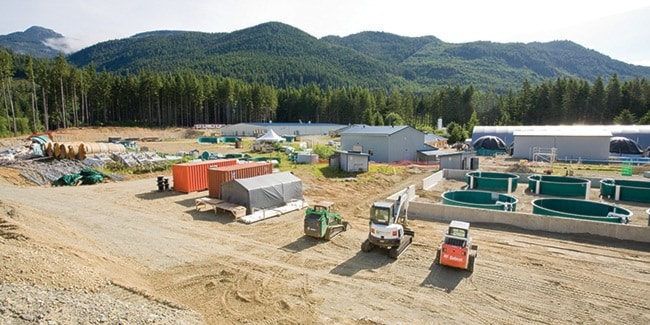Marine Harvest Canada is building seven new recirculating aquaculture systems at its two North Vancouver Island salmon farms.
The $40-million dollar infrastructure investment at the company’s Big Tree Creek and Dalrymple facilities has now begun, and will continue through 2016.
“The new land-based tank systems for raising parr and smolts (juvenile salmon prior to seawater entry) represent a significant investment in hatchery infrastructure,” the announcement says, “and will enable the company to increase production while also improving environmental performance. Recirculation uses about one-hundredth of the freshwater as a traditional flow-through aquaculture system.”
Marine Harvest Canada has been using and developing recirculating aquaculture systems since the late 1990s and has pioneering knowledge of system design and operation, the release states.
“The new systems will improve upon recirculating aquaculture technology currently being used for first feeders at Dalrymple.”
The existing system was designed and built in-house, incorporating technology from InterAqua and Pentair for bio-filter and drum-filter components.
Dean Guest, freshwater production director for Marine Harvest Canada, says it is, “the company’s most efficient system to date,” with 15 million fry fed in the first 18 months of operation.
“It was surprising that a simple system that was inexpensive to build uses less energy than competing systems. We designed the system to be very simple and compact and the only automation is the oxygen system and the drum filter,” Dean says.
“I would be shocked if I saw anything better. Performance has met or exceeded our expectations. The engineering design is unique because water flows throughout the system without the many pipes and valves required in older models. The full flow passes through each process of the treatment system with no side stream components or use of piping.”
Marine Harvest will build two first feed systems and five smolt systems, for a total of 9,000 cubic metres of rearing space.
When construction is completed, both facilities will be amongst the largest producers of salmon smolts in North America.
The company says it will be local builders and electrical contractors working on the projects, many of which have already begun, but details about the number of locals being put to work and the types of work being done by them was not made available to the Mirror by print deadline.
The first stage to be finished will be a six metre system at Dalrymple and it is expected to be ready for fish in early 2016.
